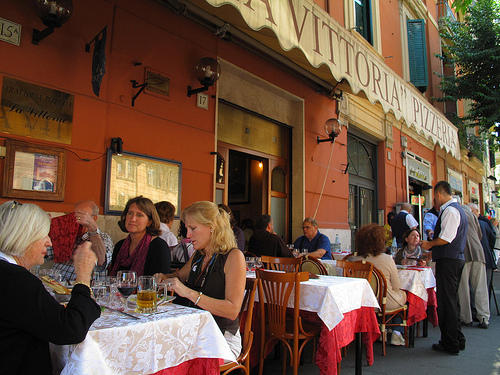Eating out - Lesson 1 - Conversation:
Volete prendere un aperitivo prima di mangiare?
(Ordering aperitifs)
(photo
by MargaretNapier used
under terms of Creative Commons license.)

|
Capo Cameriere: |
Buona sera, Signori. |
|
Don
Smith: |
Una tavola per due, per favore. |
|
Cameriere: |
Prego, da questa parte. |
|
Don
Smith: |
Cameriere, il menù, per cortesia. |
|
Cameriere: |
Ecco. Volete prendere un
aperitivo? |
|
Signora Smith: |
Io prenderei un Campari soda. |
|
Cameriere: |
Va bene, Signora. E per il Signore? |
|
Dgn Smith: |
Io
vorrei uno scotch con ghiaccio. |
|
Cameriere: |
Molto bene. Grazie. |
Translation:
|
Headwaiter: |
Good
evening, sir, ma'am. |
|
Don
Smith: |
A
table for two, please. |
|
Waiter:
|
This
way, please. |
|
Don
Smith: |
Waiter,
the menu, please. |
|
Waiter:
|
Here
you are. Would you like (to take) an aperitif? |
|
Mrs.
Smith: |
I'll
take a Campari and soda. |
|
Waiter:
|
All
right, ma'am. And for the gentleman? |
|
Don
Smith: |
I
would like a scotch on the rocks. |
|
Waiter:
|
Very
well. Thanks. |
Notes on conversation
1. Other words for il menù are la
lista (della vivande),
literally "the list (of food)," and la carta. La carta is the list of
appetizers, pastas, meat and fish dishes, vegetables and desserts from
which
you can choose. When you order alla carta, you pay for each item
separately. Il
menù a prezzo fisso, a list of complete meals with different courses
for a set
price, is sometimes referred to in the
2. Prenderei, "I would take."
3. Con ghiaccio, "with ice."
4. If you eat at a ristorante, you are expected to order a complete meal. A trattoria is a family type restaurant where local food is mainly served. A pizzeria is a restaurant for pizza and first courses. Tavola calda is a snack bar. Many restaurants have menu turistico, a tourist menu, and offer complete meals at fixed and reasonable prices. Lunch, served from 12:30 to 2:30 is the most important meal of the day. Supper, served from 7:30 to 10:30 is usually a light meat.